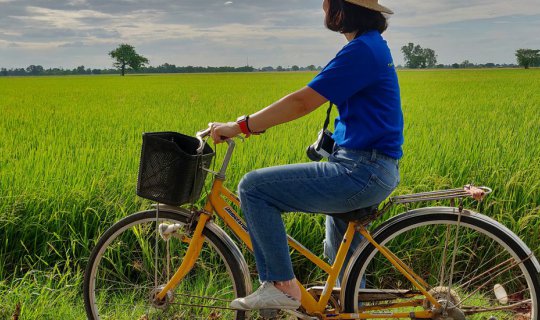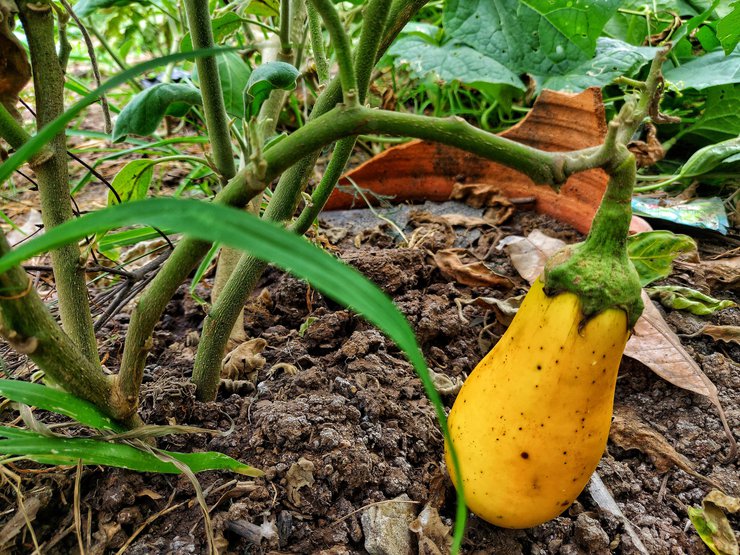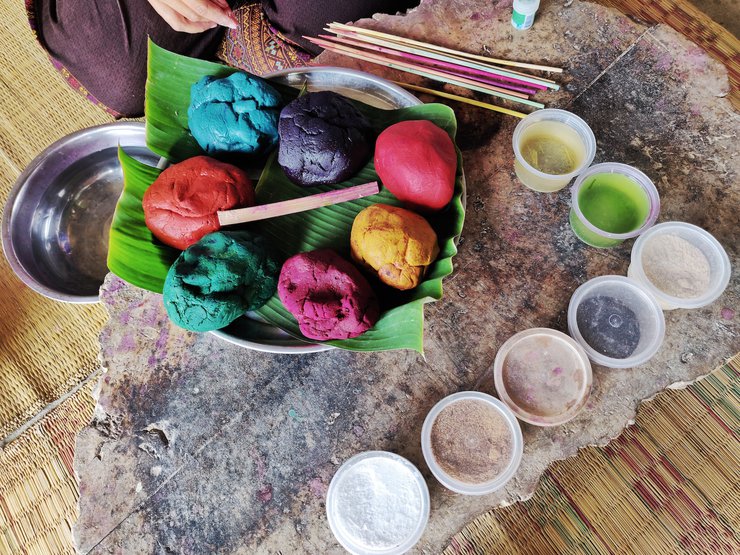On our fourth day in Ban Laem village, Suphanburi, we learnt how to grow organic vegetables, how to make incense sticks, how to make brooms out of coconut trees and how to cook traditional Thai desserts. Oh, we also visited a temple! I’m now convinced that this community is as self-sufficient as possible.

All our food is grown here
Our first stop for the day was an organic vegetable farm. Over the last few days, we have been eating delicious meals every day. Now, it was time to find out where they come from.

Our host took us to an organic farm nearby. “All our food is grown here.” – he said. It was perhaps not far from the truth, considering anything from chilis and lime to lentils and pumpkin could be found here.
We walked around and came across a variety of vegetables, a few of which could only be found near Ban Laem, I was told. We ducked beneath a bamboo like structure crafted for the purpose of providing shade to certain plants and picked out some ripe veggies.

Then, we proceeded to pick out some chilis, lime, and lentils.
“Feel the lentil. This one is just nice. Not too soft, not too hard.” – Our local guide translated as the owner of the farm went on imparting us valuable information in fluent Thai.

After another round of plucking, we now had enough raw materials to cook lunch! But before lunch, we had more activities planned.
Making multi-coloured incense sticks
Our next activity was making incense sticks. In Thailand, your birthday is associated with a colour. For example, I was born on a Monday, so my colour is yellow. Consequently, I had to make a yellow incense stick.
While the number of ingredients is plenty, the process is fairly straightforward. Mix equal amount of flour, a powder obtained from corn, lemongrass water, Pandan leaves water, the residue of coffee and sawdust (wood powder) to make a paste. The paste will resemble clay in texture. Colours are usually added using natural ingredients from various plants.

Apply this paste on a bamboo stick and rub it with wet hands to even it out. If the strokes are right, the incense stick will soon be ready for drying!
Another fun experiment is creating multi-coloured incense sticks. For this, roll a little bit of every coloured paste on top of each other and gently rub them to smoothen it out. We collected our souvenir of a packet of incense sticks and headed over to the next natural destination that should follow – a temple of course!
Bad luck, a delightful monk and 88 bells

A few minutes away lay a moderate sized typical Buddhist temple. We put on our Patungs (think Sarong but slightly different) and headed inside.
After offering our prayers and burning the incense sticks, we decided to take part in the traditional fortune telling ritual. Traditionally, you would shake a bunch of numbered sticks until just one of them falls out. The number on the stick is to be remembered.

At a nearby location, lies a box with multiple shelves, each with a number. Open the shelf with your chosen number, pick out the paper, and read it out. If it's good fortune, take it with you, if it's bad, you can return it to the shelf.
Given my amazing luck, of course it wasn't anything good, so we left the paper and hopefully my misfortune on the shelf!
Around this time, a delightful monk entered the temple. Our local host introduced us and we bowed down to offer him the usual prayers. The monk spent the next few hours telling us about the history of this temple as well as showing us around the temple’s museum. The museum featured replicas of various equipment that were used in the past – from bullock carts to machines that separate rice from its shell. It also contained scriptures as well as vases, baskets and other items from different eras.

Listening to the monk passionately explain every small detail of this museum, I couldn’t help but regret not speaking Thai. Of course, my local guide tried to translate the important parts but like any language, so much is lost in translation.
The monk went on to tell us that this temple has 88 bells. 8 resembles the sign of infinity which is considered to be auspicious in Buddhism! We went ahead and rang every one of the 88 bells before proceeding to the backyard which contained one of the oldest bells from Ayuthaya period.
As we entered the backyard, about 7-8 stray dogs started barking at us.
“A lot of people leave the dogs here. So, the monk takes care of them.” – Our local guide informed us.
The oldest bell contained certain inscriptions, which the monk translated after ringing the bell. We offered him our prayers and took our leave.
Making brooms out of coconut trees
If you thought the Ban Laem community was self-sufficient only in terms of food, think again! After a lavish spread of lunch, we went to meet an old man who taught us how to make brooms out of coconut trees.
For this, first you must choose an aged leaf and slice out the midrib of the leaf, leaving behind the petals. The midribs are then left to dry in the sun for a couple of days. Once ready, they are tied together in small bunches.

To make a broom, you have to skilfully tie at least 7-8 small bunches together, making sure the rope is as tight as possible! We had now learnt yet another life skill. I’m beginning to think I am now ready to live in a Robinson Crusoe island!
Never too full for desserts

Sure, we might have had lunch only an hour earlier, but dessert goes to the heart, right? Following our saga of learning how to make traditional Thai desserts, we visited another house known for making two fried desserts -- Kembang Goyang and Kue Rokok (similar to Thong pub which we made the previous day).
While making Kembang Goyang is a fun task, Kue Rokok is just as difficult. The easy one simply requires you to dip a readymade mould into the mixture and pop it on hot oil. The difficult one requires you to spread the mixture on a thin closed pan which resembles a waffle maker. The mixture must be spread on a thin line. After a few minutes, you have to fold the pancake on a round stick to make rolls. This is way harder than it appears! Needless to say, our version of the roll was nowhere close to the ones our teacher made. Nevertheless, we were happy we were applauded for our performance!

We ended the day with a short bicycle ride in the rice fields and a delightful dinner as usual.

As I reflect on this jam-packed day over dinner, I am beginning to realise that more than anything this trip is turning out to be a fantastic learning experience. Life in the village is different. Convenience is a rarity, but self-sufficiency is not. If not anything else, this trip has definitely equipped a city girl like me with some valuable life skills!
Madhurima Dutta
Sunday, July 28, 2019 1:43 AM











